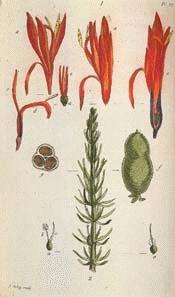
Botanical.com Home Page

|
Mare's Tail
(Hippuris melanocarpa printed as
Hippuris vulgaris LINN.)
Click on graphic for larger image
|
Mare's Tail
Botanical: Hippuris vulgaris (LINN.)
Family: N.O. Haloragaceae
---Synonyms---Female Horsetail. Marsh Barren Horsetail.
The Mare's Tail (Hippuris vulgaris) must not be confused with the Horsetail (Equisetum arvense). The Mare's Tail is an aquatic flowering plant, the only British species of a group of plants found growing nearly all over Europe, Russia, Central Asia, and North America. It has a superficial resemblance to the Horsetails, having the same erect, many-jointed stems about as thick as a goosequill, unbranched, except at the base, and tapering to a point, crowded in the whole length by whorls of eight to twelve very narrow leaves 1/2 to 1 1/3 inch long, closely set with hard tips.
The inconspicuous flowers are sessile, i.e. stalkless, in the axils of the upper leaves and consist of a minute calyx, forming an indistinctly two-lobed rim to the ovary a solitary stamen, with red anthers and a single seed. Some of the flowers are often without stamens. They appear in June and July.
In stagnant water the plant grows erect, in running water it bends with the stream, swimming on the surface. The stems are as a rule about 2 feet long.
- Culpepper, in common with the older herbalists, considered it of great value as a vulnerary:
- 'It is very powerful to stop bleeding, either inward or outward, the juice or the decoction being drunk, or the juice, decoction or distilled water applied outwardly.... It also heals inward ulcers.... It solders together the tops of green wounds and cures all ruptures in children. The decoction taken in wine helps stone and strangury; the distilled water drunk two or three times a day eases and strengthens the intestines and is effectual in a cough that comes by distillation from the head. The juice or distilled water used as a warm fomentation is of service in inflammations and breakings-out in the skin.'
The Mare's Tail is not uncommon in shallow ponds, the margins of lakes, etc. where there is a depth of mud and frost cannot reach the roots, which are stout and creeping. When the water is shallow, the upper part of the stem is stout and projects out of the water to a height of 8 inches to a foot or more. The submerged leaves, when the plant grows in deep streams, are often 2 to 3 inches long, paler and broader than those above water.
In some countries it is a troublesome weed in rivers and chokes up the ditches. It has been supposed to assist in purifying the putrid air of marshes by absorbing a great quantity of marsh gas. Goats are said to eat it, and in the north wild ducks to feed on it.
Gerard calls the plant Female Horsetail, and Parkinson Marsh Barren Horsetail. The name, Hippuris, is the Greek word for Mare's Tail.
See (WATER) MILFOIL.
[Top]
Common Name Index
A MODERN HERBAL Home Page
Bear in mind "A Modern Herbal" was written with the conventional wisdom of the early 1900's. This should be taken into account as some of the information may now be considered inaccurate, or not in accordance with modern medicine.
© Copyright Protected 1995-2024 Botanical.com
|

